Working with Objects
The majority of work in an Objective-C application happens as a result of messages being sent back and forth across an ecosystem of objects. Some of these objects are instances of classes provided by Cocoa or Cocoa Touch, some are instances of your own classes.
The previous chapter described the syntax to define the interface and implementation for a class, including the syntax to implement methods containing the code to be executed in response to a message. This chapter explains how to send such a message to an object, and includes coverage of some of Objective-C’s dynamic features, including dynamic typing and the ability to determine which method should be invoked at runtime.
Before an object can be used, it must be created properly using a combination of memory allocation for its properties and any necessary initialization of its internal values. This chapter describes how to nest the method calls to allocate and initialize an object in order to ensure that it is configured correctly.
Objects Send and Receive Messages
Although there are several different ways to send messages between objects in Objective-C, by far the most common is the basic syntax that uses square brackets, like this:
[someObject doSomething]; |
The reference on the left, someObject in this case, is the receiver of the message. The message on the right, doSomething, is the name of the method to call on that receiver. In other words, when the above line of code is executed, someObject will be sent the doSomething message.
The previous chapter described how to create the interface for a class, like this:
@interface XYZPerson : NSObject |
- (void)sayHello; |
@end |
and how to create the implementation of that class, like this:
@implementation XYZPerson |
- (void)sayHello { |
NSLog(@"Hello, world!"); |
} |
@end |
Assuming you’ve got hold of an XYZPerson object, you could send it the sayHello message like this:
[somePerson sayHello]; |
Sending an Objective-C message is conceptually very much like calling a C function. Figure 2-1 shows the effective program flow for the sayHello message.
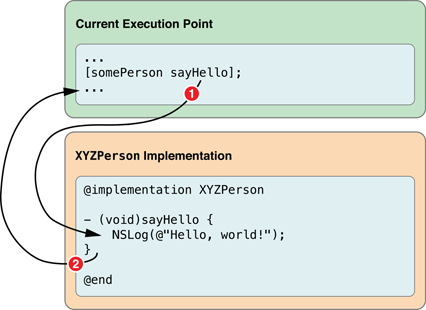
In order to specify the receiver of a message, it’s important to understand how pointers are used to refer to objects in Objective-C.
Use Pointers to Keep Track of Objects
C and Objective-C use variables to keep track of values, just like most other programming languages.
There are a number of basic scalar variable types defined in standard C, including integers, floating-point numbers and characters, which are declared and assigned values like this:
int someInteger = 42; |
float someFloatingPointNumber = 3.14f; |
Local variables, which are variables declared within a method or function, like this:
- (void)myMethod { |
int someInteger = 42; |
} |
are limited in scope to the method in which they are defined.
In this example, someInteger is declared as a local variable inside myMethod; once execution reaches the closing brace of the method, someInteger will no longer be accessible. When a local scalar variable (like an int or a float) goes away, the value disappears too.
Objective-C objects, by contrast, are allocated slightly differently. Objects normally have a longer life than the simple scope of a method call. In particular, an object often needs to stay alive longer than the original variable that was created to keep track of it, so an object’s memory is allocated and deallocated dynamically.
This requires you to use C pointers (which hold memory addresses) to keep track of their location in memory, like this:
- (void)myMethod { |
NSString *myString = // get a string from somewhere... |
[...] |
} |
Although the scope of the pointer variable myString (the asterisk indicates it’s a pointer) is limited to the scope of myMethod, the actual string object that it points to in memory may have a longer life outside that scope. It might already exist, or you might need to pass the object around in additional method calls, for example.
You Can Pass Objects for Method Parameters
If you need to pass along an object when sending a message, you supply an object pointer for one of the method parameters. The previous chapter described the syntax to declare a method with a single parameter:
- (void)someMethodWithValue:(SomeType)value; |
The syntax to declare a method that takes a string object, therefore, looks like this:
- (void)saySomething:(NSString *)greeting; |
You might implement the saySomething: method like this:
- (void)saySomething:(NSString *)greeting { |
NSLog(@"%@", greeting); |
} |
The greeting pointer behaves like a local variable and is limited in scope just to the saySomething: method, even though the actual string object that it points to existed prior to the method being called, and will continue to exist after the method completes.
Methods Can Return Values
As well as passing values through method parameters, it’s possible for a method to return a value. Each method shown in this chapter so far has a return type of void. The C void keyword means a method doesn’t return anything.
Specifying a return type of int means that the method returns a scalar integer value:
- (int)magicNumber; |
The implementation of the method uses a C return statement to indicate the value that should be passed back after the method has finished executing, like this:
- (int)magicNumber { |
return 42; |
} |
It’s perfectly acceptable to ignore the fact that a method returns a value. In this case the magicNumber method doesn’t do anything useful other than return a value, but there’s nothing wrong with calling the method like this:
[someObject magicNumber]; |
If you do need to keep track of the returned value, you can declare a variable and assign it to the result of the method call, like this:
int interestingNumber = [someObject magicNumber]; |
You can return objects from methods in just the same way. The NSString class, for example, offers an uppercaseString method:
- (NSString *)uppercaseString; |
It’s used in the same way as a method returning a scalar value, although you need to use a pointer to keep track of the result:
NSString *testString = @"Hello, world!"; |
NSString *revisedString = [testString uppercaseString]; |
When this method call returns, revisedString will point to an NSString object representing the characters HELLO WORLD!.
Remember that when implementing a method to return an object, like this:
- (NSString *)magicString { |
NSString *stringToReturn = // create an interesting string... |
return stringToReturn; |
} |
the string object continues to exist when it is passed as a return value even though the stringToReturn pointer goes out of scope.
There are some memory management considerations in this situation: a returned object (created on the heap) needs to exist long enough for it to be used by the original caller of the method, but not in perpetuity because that would create a memory leak. For the most part, the Automatic Reference Counting (ARC) feature of the Objective-C compiler takes care of these considerations for you.
Objects Can Send Messages to Themselves
Whenever you’re writing a method implementation, you have access to an important hidden value, self. Conceptually, self is a way to refer to “the object that’s received this message.” It’s a pointer, just like the greeting value above, and can be used to call a method on the current receiving object.
You might decide to refactor the XYZPerson implementation by modifying the sayHello method to use the saySomething: method shown above, thereby moving the NSLog() call to a separate method. This would mean you could add further methods, like sayGoodbye, that would each call through to the saySomething: method to handle the actual greeting process. If you later wanted to display each greeting in a text field in the user interface, you’d only need to modify the saySomething: method rather than having to go through and adjust each greeting method individually.
The new implementation using self to call a message on the current object would look like this:
@implementation XYZPerson |
- (void)sayHello { |
[self saySomething:@"Hello, world!"]; |
} |
- (void)saySomething:(NSString *)greeting { |
NSLog(@"%@", greeting); |
} |
@end |
If you sent an XYZPerson object the sayHello message for this updated implementation, the effective program flow would be as shown in Figure 2-2.
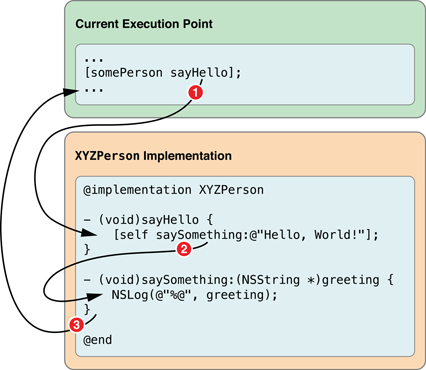
Objects Can Call Methods Implemented by Their Superclasses
There’s another important keyword available to you in Objective-C, called super. Sending a message to super is a way to call through to a method implementation defined by a superclass further up the inheritance chain. The most common use of super is when overriding a method.
Let’s say you want to create a new type of person class, a “shouting person” class, where every greeting is displayed using capital letters. You could duplicate the entire XYZPerson class and modify each string in each method to be uppercase, but the simplest way would be to create a new class that inherits from XYZPerson, and just override the saySomething: method so that it displays the greeting in uppercase, like this:
@interface XYZShoutingPerson : XYZPerson |
@end |
@implementation XYZShoutingPerson |
- (void)saySomething:(NSString *)greeting { |
NSString *uppercaseGreeting = [greeting uppercaseString]; |
NSLog(@"%@", uppercaseGreeting); |
} |
@end |
This example declares an extra string pointer, uppercaseGreeting and assigns it the value returned from sending the original greeting object the uppercaseString message. As you saw earlier, this will be a new string object built by converting each character in the original string to uppercase.
Because sayHello is implemented by XYZPerson, and XYZShoutingPerson is set to inherit from XYZPerson, you can call sayHello on an XYZShoutingPerson object as well. When you call sayHello on an XYZShoutingPerson, the call to [self saySomething:...] will use the overridden implementation and display the greeting as uppercase, resulting in the effective program flow shown in Figure 2-3.
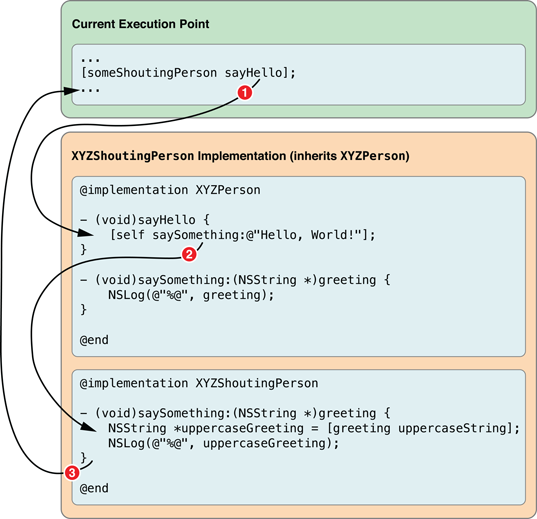
The new implementation isn’t ideal, however, because if you did decide later to modify the XYZPerson implementation of saySomething: to display the greeting in a user interface element rather than through NSLog(), you’d need to modify the XYZShoutingPerson implementation as well.
A better idea would be to change the XYZShoutingPerson version of saySomething: to call through to the superclass (XYZPerson) implementation to handle the actual greeting:
@implementation XYZShoutingPerson |
- (void)saySomething:(NSString *)greeting { |
NSString *uppercaseGreeting = [greeting uppercaseString]; |
[super saySomething:uppercaseGreeting]; |
} |
@end |
The effective program flow that now results from sending an XYZShoutingPerson object the sayHello message is shown in Figure 2-4.
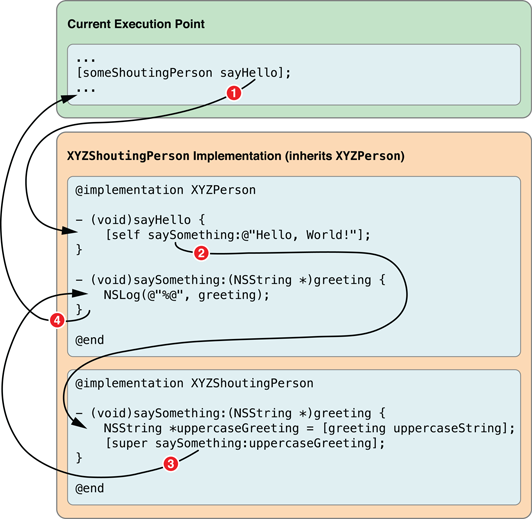
Objects Are Created Dynamically
As described earlier in this chapter, memory is allocated dynamically for an Objective-C object. The first step in creating an object is to make sure enough memory is allocated not only for the properties defined by an object’s class, but also the properties defined on each of the superclasses in its inheritance chain.
The NSObject root class provides a class method, alloc, which handles this process for you:
+ (id)alloc; |
Notice that the return type of this method is id. This is a special keyword used in Objective-C to mean “some kind of object.” It is a pointer to an object, like (NSObject *), but is special in that it doesn’t use an asterisk. It’s described in more detail later in this chapter, in Objective-C Is a Dynamic Language.
The alloc method has one other important task, which is to clear out the memory allocated for the object’s properties by setting them to zero. This avoids the usual problem of memory containing garbage from whatever was stored before, but is not enough to initialize an object completely.
You need to combine a call to alloc with a call to init, another NSObject method:
- (id)init; |
The init method is used by a class to make sure its properties have suitable initial values at creation, and is covered in more detail in the next chapter.
Note that init also returns an id.
If one method returns an object pointer, it’s possible to nest the call to that method as the receiver in a call to another method, thereby combining multiple message calls in one statement. The correct way to allocate and initialize an object is to nest the alloc call inside the call to init, like this:
NSObject *newObject = [[NSObject alloc] init]; |
This example sets the newObject variable to point to a newly created NSObject instance.
The innermost call is carried out first, so the NSObject class is sent the alloc method, which returns a newly allocated NSObject instance. This returned object is then used as the receiver of the init message, which itself returns the object back to be assigned to the newObject pointer, as shown in Figure 2-5.
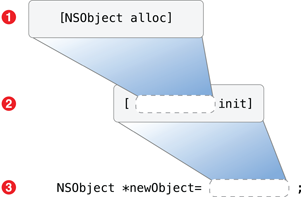
Initializer Methods Can Take Arguments
Some objects need to be initialized with required values. An NSNumber object, for example, must be created with the numeric value it needs to represent.
The NSNumber class defines several initializers, including:
- (id)initWithBool:(BOOL)value; |
- (id)initWithFloat:(float)value; |
- (id)initWithInt:(int)value; |
- (id)initWithLong:(long)value; |
Initialization methods with arguments are called in just the same way as plain init methods—an NSNumber object is allocated and initialized like this:
NSNumber *magicNumber = [[NSNumber alloc] initWithInt:42]; |
Class Factory Methods Are an Alternative to Allocation and Initialization
As mentioned in the previous chapter, a class can also define factory methods. Factory methods offer an alternative to the traditional alloc] init] process, without the need to nest two methods.
The NSNumber class defines several class factory methods to match its initializers, including:
+ (NSNumber *)numberWithBool:(BOOL)value; |
+ (NSNumber *)numberWithFloat:(float)value; |
+ (NSNumber *)numberWithInt:(int)value; |
+ (NSNumber *)numberWithLong:(long)value; |
A factory method is used like this:
NSNumber *magicNumber = [NSNumber numberWithInt:42]; |
This is effectively the same as the previous example using alloc] initWithInt:]. Class factory methods usually just call straight through to alloc and the relevant init method, and are provided for convenience.
Use new to Create an Object If No Arguments Are Needed for Initialization
It’s also possible to create an instance of a class using the new class method. This method is provided by NSObject and doesn’t need to be overridden in your own subclasses.
It’s effectively the same as calling alloc and init with no arguments:
XYZObject *object = [XYZObject new]; |
// is effectively the same as: |
XYZObject *object = [[XYZObject alloc] init]; |
Literals Offer a Concise Object-Creation Syntax
Some classes allow you to use a more concise, literal syntax to create instances.
You can create an NSString instance, for example, using a special literal notation, like this:
NSString *someString = @"Hello, World!"; |
This is effectively the same as allocating and initializing an NSString or using one of its class factory methods:
NSString *someString = [NSString stringWithCString:"Hello, World!" |
encoding:NSUTF8StringEncoding]; |
The NSNumber class also allows a variety of literals:
NSNumber *myBOOL = @YES; |
NSNumber *myFloat = @3.14f; |
NSNumber *myInt = @42; |
NSNumber *myLong = @42L; |
Again, each of these examples is effectively the same as using the relevant initializer or a class factory method.
You can also create an NSNumber using a boxed expression, like this:
NSNumber *myInt = @(84 / 2); |
In this case, the expression is evaluated, and an NSNumber instance created with the result.
Objective-C also supports literals to create immutable NSArray and NSDictionary objects; these are discussed further in Values and Collections.
Objective-C Is a Dynamic Language
As mentioned earlier, you need to use a pointer to keep track of an object in memory. Because of Objective-C’s dynamic nature, it doesn’t matter what specific class type you use for that pointer—the correct method will always be called on the relevant object when you send it a message.
The id type defines a generic object pointer. It’s possible to use id when declaring a variable, but you lose compile-time information about the object.
Consider the following code:
id someObject = @"Hello, World!"; |
[someObject removeAllObjects]; |
In this case, someObject will point to an NSString instance, but the compiler knows nothing about that instance beyond the fact that it’s some kind of object. The removeAllObjects message is defined by some Cocoa or Cocoa Touch objects (such as NSMutableArray) so the compiler doesn’t complain, even though this code would generate an exception at runtime because an NSString object can’t respond to removeAllObjects.
Rewriting the code to use a static type:
NSString *someObject = @"Hello, World!"; |
[someObject removeAllObjects]; |
means that the compiler will now generate an error because removeAllObjects is not declared in any public NSString interface that it knows about.
Because the class of an object is determined at runtime, it makes no difference what type you assign a variable when creating or working with an instance. To use the XYZPerson and XYZShoutingPerson classes described earlier in this chapter, you might use the following code:
XYZPerson *firstPerson = [[XYZPerson alloc] init]; |
XYZPerson *secondPerson = [[XYZShoutingPerson alloc] init]; |
[firstPerson sayHello]; |
[secondPerson sayHello]; |
Although both firstPerson and secondPerson are statically typed as XYZPerson objects, secondPerson will point, at runtime, to an XYZShoutingPerson object. When the sayHello method is called on each object, the correct implementations will be used; for secondPerson, this means the XYZShoutingPerson version.
Determining Equality of Objects
If you need to determine whether one object is the same as another object, it’s important to remember that you’re working with pointers.
The standard C equality operator == is used to test equality between the values of two variables, like this:
if (someInteger == 42) { |
// someInteger has the value 42 |
} |
When dealing with objects, the == operator is used to test whether two separate pointers are pointing to the same object:
if (firstPerson == secondPerson) { |
// firstPerson is the same object as secondPerson |
} |
If you need to test whether two objects represent the same data, you need to call a method like isEqual:, available from NSObject:
if ([firstPerson isEqual:secondPerson]) { |
// firstPerson is identical to secondPerson |
} |
If you need to compare whether one object represents a greater or lesser value than another object, you can’t use the standard C comparison operators > and <. Instead, the basic Foundation types, like NSNumber, NSString and NSDate, provide a compare: method:
if ([someDate compare:anotherDate] == NSOrderedAscending) { |
// someDate is earlier than anotherDate |
} |
Working with nil
It’s always a good idea to initialize scalar variables at the time you declare them, otherwise their initial values will contain garbage from the previous stack contents:
BOOL success = NO; |
int magicNumber = 42; |
This isn’t necessary for object pointers, because the compiler will automatically set the variable to nil if you don’t specify any other initial value:
XYZPerson *somePerson; |
// somePerson is automatically set to nil |
A nil value is the safest way to initialize an object pointer if you don’t have another value to use, because it’s perfectly acceptable in Objective-C to send a message to nil. If you do send a message to nil, obviously nothing happens.
If you need to check to make sure an object is not nil (that a variable points to an object in memory), you can either use the standard C inequality operator:
if (somePerson != nil) { |
// somePerson points to an object |
} |
or simply supply the variable:
if (somePerson) { |
// somePerson points to an object |
} |
If the somePerson variable is nil, its logical value is 0 (false). If it has an address, it’s not zero, so evaluates as true.
Similarly, if you need to check for a nil variable, you can either use the equality operator:
if (somePerson == nil) { |
// somePerson does not point to an object |
} |
or just use the C logical negation operator:
if (!somePerson) { |
// somePerson does not point to an object |
} |
Exercises
Open the
main.mfile in your project from the exercises at the end of the last chapter and find themain()function. As with any executable written in C, this function represents the starting point for your application.Create a new
XYZPersoninstance usingallocandinit, and then call thesayHellomethod.Implement the
saySomething:method shown earlier in this chapter, and rewrite thesayHellomethod to use it. Add a variety of other greetings and call each of them on the instance you created above.Create new class files for the
XYZShoutingPersonclass, set to inherit fromXYZPerson.Override the
saySomething:method to display the uppercase greeting, and test the behavior on anXYZShoutingPersoninstance.Implement the
XYZPersonclasspersonfactory method you declared in the previous chapter, to return a correctly allocated and initialized instance of theXYZPersonclass, then use the method inmain()instead of your nestedallocandinit.Create a new local
XYZPersonpointer, but don’t include any value assignment.Use a branch (
ifstatement) to check whether the variable is automatically assigned asnil.
Copyright © 2014 Apple Inc. All Rights Reserved. Terms of Use | Privacy Policy | Updated: 2014-09-17